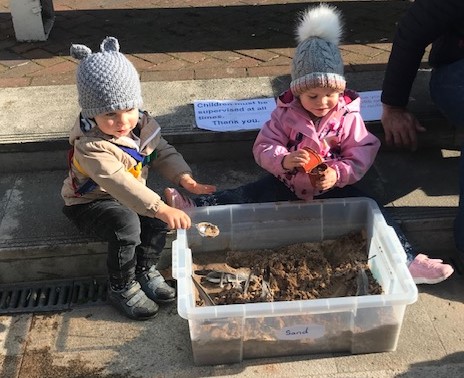What was your play pilot?
We decided to run six sessions on a Monday morning outside the front of the museum. Each session was to have a loose theme based around Poole: under the sea, on the sea, on the beach, on the land, in the sky and in Poole.
Each week we put out simple play resources and activities for children to use: bubbles, chalk, water, wet and dry sand, paper, crayons, cardboard boxes, buckets and brushes. We varied them slightly depending on the theme. For example, we started a different chalk picture each week for children to add to. We had a different paper craft each session. When we were on the beach, it was make an ice cream, and for on the sea, make a pirate hat.
We kept an activity the following week if it proved to be popular. Playing with bubbles and painting with water and big paint brushes happened every week.
We put out wet and dry sand each week with different items in it to play with, depending on our theme. The idea was not to be prescriptive but to offer resources and examples of ways to play. We wanted to encourage free play and discovery and using imagination.
We also put up a picture of something inside Poole Museum that was related to the theme to encourage people to go and find it inside.
As it was during school time, we were aiming at pre-school children and their adults. One of the sessions was during half term so we expected to get some older children. The activities were such that any age group could join in to their own ability. We had an older child who was home schooled who came regularly and enjoyed the time.
The sessions were advertised on social media and the museum’s website. The attendance at the sessions was rather weather dependent. If the morning was rather dull or wet, less people would come. We promised to be there ‘rain or shine’ but did not have any wet weather shelter. That said, we were very lucky with the weather especially as it was September/October.
Due to COVID-19 we were careful to get all participants to hand sanitize before playing and to keep a distance from other families. We collected used items during the session to clean before others used them. One downside to the COVID-19 restrictions was that we, as separate adults, could not play with the children as much as on a normal occasion.
Budget
£
For materials. We tried to use items that we already had. We used newspaper, old cardboard boxes, borrowed large paintbrushes and home made bubble blowers. The main cost was 1.5 hours paid time for each session for support by one of our Learning Activity Leaders.
What would you consider your level of experience in creating playful interventions in museums prior to the project (1 being the least experienced and 5 being the most)?
5 for one member of staff and 3 for the other
Why did your organisation choose to take part?
When we heard of the project, we thought it would be great. As part of the Learning team, we are constantly trying to make more opportunities to play in the museum, especially for small children. It is sometimes thought there is not enough room, so to take part in a programme to do some playing outside was ideal.
We wanted some inspiration for playful interventions regarding our National Lottery Heritage Fund capital project.
We wanted to advocate for play to the wider museum team.
What did you achieve?
I think we managed to spread a little playfulness and give some families enjoyment. The sessions went well and people returned so they must have enjoyed the time. We got some good feedback which helps in our task to spread the idea that play can happen in a museum.
We engaged some people who had not been to the museum before. We learnt that you don’t need expensive resources to have fun. As a result of the project, we are hoping to embed play within our National Lottery Heritage Fund redevelopment and develop some in house ‘playful’ training for the wider museum team.
Lessons learnt
We need to keep advertising what is happening in as many places as possible. The last week had more attendees because people were coming to do a special half term trail in the museum and found us outside.
It would be good to do this more often but funding could be an issue. Due to COVID-19, the Learning Activity Leader was being paid average hours anyway which covered most of the cost. Normally this would not happen.
Letting the Front of House team know what was going on was really important for the smooth running of the project.
Top tips
- Get advice from Health and Safety professionals regarding safe play in the pandemic.
- Brief your Front of House team to help with the smooth running of the project.
- Clear signage and guidelines are really important so families know where to go, what the activity is and who is running it.
- Talk to your parents, carers and children, and listen to their needs.
- Use social media to advertise your activities.
- It sounds obvious but be friendly and welcoming.
- Don’t be scared of trying new things and don’t be too prescriptive.
- Last but not least, have fun!
The Play in Museums in a Socially Distanced World project was made possible by the National Lottery Heritage Fund.
Categories: Play
Audience: Family

